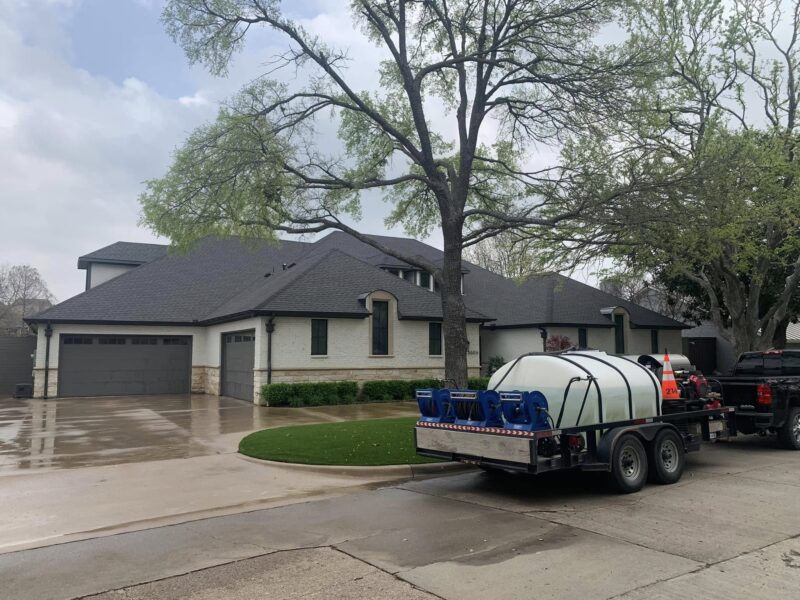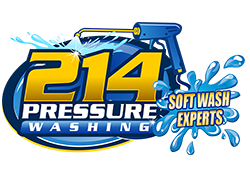Beat Allergies: How Pressure Washing Removes Pollen
Summer arrives with a beautiful paradox: blooming flowers that make your property gorgeous while simultaneously coating everything in a fine yellow dust that sends your family reaching for tissues. If you’ve noticed your allergy symptoms seem worse when you’re at home, your house’s exterior might be harboring more pollen and allergens than you realize.
The connection between outdoor allergens and indoor air quality runs deeper than most homeowners understand. While you diligently change air filters and vacuum regularly, the exterior surfaces of your home act like massive collection plates for pollen, mold spores, and other airborne irritants. These accumulated allergens don’t just stay put—they find their way into your living space every time you open a door or window.
Professional pressure washing offers a powerful solution that goes far beyond improving your home’s appearance. At 214 Pressure Washing, we’ve seen firsthand how targeted exterior cleaning can dramatically reduce allergy symptoms for families throughout our service area. When done correctly with the right techniques and equipment, pressure washing can significantly reduce the allergen load around your property and create a healthier environment for your family.

Understanding How Allergens Accumulate on Your Home
Your home’s exterior surfaces face a constant barrage of airborne particles throughout allergy season. Siding, decks, patios, and rooflines become magnets for tree pollen, grass pollen, and mold spores. These microscopic irritants embed themselves in textured surfaces and accumulate in corners, crevices, and horizontal surfaces where they’re protected from natural rainfall.
Research from the American Academy of Allergy, Asthma, and Immunology shows that pollen counts can be 50 times higher on surfaces near your home compared to areas just a few feet away. This concentration effect means your family encounters a much higher allergen load in your immediate living environment than they would experience elsewhere.
The problem intensifies because many common building materials have surfaces that trap allergens effectively. Vinyl siding with its textured finish, concrete patios with their porous surfaces, and wooden decks with their natural grain all provide perfect hiding spots for particles that trigger allergic reactions.
The Science Behind Pressure Washing and Allergen Removal
Pressure washing works by combining high-pressure water with controlled flow rates to dislodge and remove accumulated debris from surfaces. Unlike gentle rinsing with a garden hose, professional pressure washing creates enough force to penetrate into surface irregularities where allergens hide while remaining safe for your home’s materials.
The key lies in understanding that different surfaces require different approaches. Soft washing techniques use lower pressure combined with specialized cleaning solutions to safely remove biological contaminants from delicate surfaces like painted siding or roofing materials. Higher pressure settings work effectively on concrete, brick, and other durable surfaces to remove deeply embedded particles.
Temperature also plays a crucial role in allergen removal. Hot water pressure washing can break down the proteins in pollen that make them allergenic while simultaneously killing mold spores and bacteria that contribute to respiratory irritation.
Professional Techniques That Make the Difference
Effective allergen removal requires more than just spraying water at high pressure. Professional pressure washing services understand the importance of systematic cleaning patterns that ensure complete coverage without causing damage to your property.
The process typically begins with a thorough inspection to identify problem areas and determine the appropriate cleaning methods for each surface. Pre-treatment with eco-friendly cleaning solutions helps break down stubborn accumulations before the main washing begins.
Timing matters significantly in allergen removal. The most effective approach involves pressure washing during periods of lower pollen production, typically after rain or during late evening hours when pollen counts naturally decrease. This timing prevents immediate re-contamination and maximizes the duration of allergen reduction.
Professional services also understand the importance of proper water management during the cleaning process. Directing runoff away from windows, doors, and HVAC intake vents prevents allergens from being redistributed to areas where they could enter your home’s interior.
Creating Long-Term Allergen Control
While pressure washing provides immediate relief from accumulated allergens, developing a comprehensive maintenance schedule delivers the best long-term results for allergy sufferers. Most experts recommend pressure washing exterior surfaces at least twice per year, with additional cleanings during particularly heavy pollen seasons.
The investment in professional allergen removal pays dividends beyond just symptom relief. Clean exterior surfaces also improve your home’s energy efficiency by removing contaminants that can interfere with proper ventilation and air circulation around your property.
Your Path to Cleaner, Healthier Outdoor Living
Your family deserves to enjoy your outdoor spaces without constantly battling allergy symptoms. Professional pressure washing removes the hidden allergen reservoirs that make spending time on your deck, patio, or yard uncomfortable during peak allergy seasons.
Contact 214 Pressure Washing today for a comprehensive evaluation of your property’s allergen removal needs. Our experienced team will develop a customized cleaning plan that targets the specific allergens affecting your family while protecting your home’s surfaces. Schedule your free consultation and take the first step toward a more comfortable, healthier home environment.
